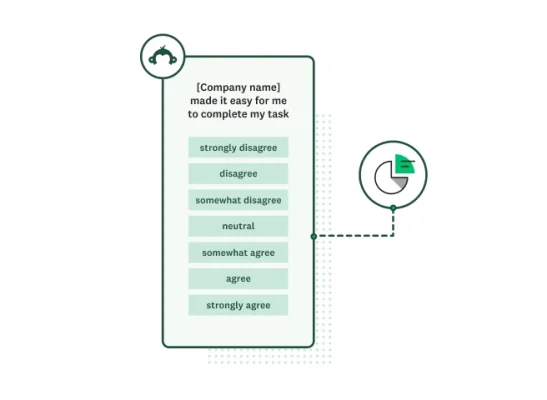Why You Should Care about the Customer Effort Score (CES)
The customer effort score (CES) is proven to predict customer loyalty and is a great tool for any customer experience (CX) team.

Most customer service professionals know the most CX metrics: the customer satisfaction (CSAT) score and the Net Promoter Score® (NPS®). The NPS measures how likely it is that customers would recommend a company to their friends or colleagues, while the CSAT score typically measures how highly customers rate the quality of specific experiences.
These CX metrics give companies vital insights into team performance and customer happiness while illuminating strengths and weaknesses that affect big-picture goals, such as reducing churn and growing revenue. But on their own, the CSAT score and the NPS could exclude a vital piece of the customer experience equation: the amount of effort a customer exerts to resolve an issue.
That’s where the customer effort score (CES) comes in. Keep reading to learn what it is, how it’s measured and why it’s vital.
What is the customer effort score?
The customer effort score asks the customer to rate the level of effort involved in performing a specific interaction. The CES is often used in customer service or other routine experiences where low effort is the main loyalty driver. For example, after a customer accesses a support article on a website, they may be asked to rate how easy it was to resolve their issue.
Why is the CES important?
When customers encounter high levels of effort, this often indicates areas that need improvement, such as complex processes or inadequate customer support. Measuring the CES not only provides valuable insights into your customer journey but also serves as a catalyst for enhancing it by pinpointing areas that require improvement.
How to measure the customer effort score
The CES survey asks customers to agree or disagree with the statement: “[Placeholder for company name] made it easy for me to handle my issue.” The respondent can choose from seven answer choices ranging from strongly disagree (score=1) to strongly agree (score=7). Here’s an example:

If someone gives you a low score, ask them why; this will help you identify trends and gain a better understanding of how to take action. For example, ask “Can you tell us more about your experience? It sounds like we could have done better.” Responses could include:
- The agent didn’t understand my question.
- The agent wasn’t knowledgeable.
- The waiting time was too long.
- My question wasn’t answered.
- The product doesn’t have the functionality that I need.
Finally, add an open-ended survey question after the CES question to gather more feedback.
When to measure customer effort
The CES question can help you collect more meaningful insights at any stage of the customer journey, but it’s instrumental after these key customer touchpoints:
- Customer service interactions (e.g. phone, email, social media, in person)
- Purchases or sales interactions
- Programme or service sign-ups
- Website visits
- Online checkouts
- Customer meetings or consultations
Measuring customer effort is particularly relevant if you provide support to your customers via multiple channels. In fact, the modern concept of omnichannel service is about reducing friction between service channels and minimising customer effort.
Once you start collecting customer feedback, you’ll have your CES results to compare alongside your CSAT scores (and your Net Promoter Score if you include the NPS question in your customer service surveys). You get a whole new layer of customer feedback that makes your data more nuanced. With more context, you can pinpoint weak processes and channels and take steps to improve them.
Customer service interactions
CES surveys ask customers to rank how difficult it was to solve a pain point that they experienced with your business. Send the customer effort score surveys immediately after a customer contacts your service team with an issue or problem.
This could be after a customer’s email support ticket has been closed or after they’ve finished reading a FAQ article in your online resources centre. Sending surveys after these interactions allows you to see how effective your support systems are at solving customer problems.
See how customer service teams can decrease churn, boost loyalty and create strong customer relationships. Learn more.
Purchases or sales interactions
Your business should also ensure that it’s easy for customers to purchase your products or services. After all, you don’t want to put up barriers to increasing revenue. Post-purchase surveys allow you to ask your customers, immediately after completion, how their purchase experience went. Did they think everything went smoothly, or were there bumps in the road that almost made them abandon their purchase? It’s vital to understand how efficient the path to purchase is for your buyers.
Programme or service sign-ups
When a new customer signs up for your programme or service, you need that process to go as smoothly as possible in order to start the customer experience off on the right foot. Once the sign-up is completed, sending a CES survey will give you a good idea of existing pain points, allowing your team to solve them. For example, you may find that you’re asking for too much information in the sign-up process. In this instance, it’s likely that eliminating a few fields in the account sign-up process will yield more conversions.
Website visits
Your website is the shop window for your business; you need to be fully confident that it’s well designed and helps users find the information and products that are most relevant to their interests.
Online checkouts
Online checkouts play a critical role in the success of e-commerce, but they frequently contain bugs or problems that discourage potential customers from finalising a purchase. To identify and address these issues in your online checkout process, consider implementing a customer effort score survey after a purchase has been either completed or abandoned. This will help you gain valuable insights into the user experience and improve your checkout process.
Customer meetings or consultations
If your sales or customer success team conducts customer meetings or consultations, you’ll retain more customers if those teams make it easy for customers to solve their problems. Send a CES survey after a meeting to see how your business is doing and track your progress over time as you make improvements.
When to use a CES, NPS and CSAT
CES is not the be-all and end-all of customer experience metrics, although it certainly is valuable. It’s most effective when combined with the two other customer experience metrics: the Net Promoter Score (NPS) and the customer satisfaction (CSAT) score. These metrics work together but are not interchangeable, so knowing when to use each one is important.
Customer effort score
As discussed in this guide, CES is best employed as a means of measuring customer effort. For example, how easy are you making it for your customers to make purchases, solve problems and generally interact with your business? This metric is less about creating happiness and satisfaction and more about avoiding unnecessary customer effort.
Net Promoter Score
The Net Promoter Score measures long-term customer loyalty. It’s measured by asking customers how likely it is that they would recommend your brand, products or services to a friend or colleague. Additionally, the NPS will determine whether your customer experience is creating loyalty in the long term.
It helps you determine which customers are brand ambassadors and which customers are more likely to defect to your competitors.
Customer satisfaction score
The CSAT score is calculated by asking customers how they would rate their satisfaction with your business, an interaction, or a product or service. The customer satisfaction score can help you measure and improve specific touchpoints along the customer journey, so it should be limited to asking about one touchpoint at a time and tracking progress for enhancing that touchpoint. If the CSAT score is lower at one point of the journey, you can focus your efforts there to start making effective improvements to the customer experience.
Improving customer service with the CES
Predict follow-up questions and address them proactively
Companies can reduce call-back and case-reopen rates by training their customer service team to answer common follow-up questions proactively. For example, let’s suppose that your team fields many password reset questions and customers tend to email again asking for the link to manage their account. In that case, your customer service reps should start including that link in their initial response. This simple addition can significantly reduce back and forth, saving your reps and customers time.
Make self-service easy
No one likes to shout “representative” down the phone a hundred times only to find themselves directed to the wrong place by an automated voice. If you want to make your customer service processes effortless, then look to your self-service tools first. Today’s customers are comfortable seeking answers on their own. In fact, many people prefer to resolve issues on their own. You can deflect tickets and reduce customer effort by enabling customers with the resources that they need to solve problems themselves.
Ask your frontline team for feedback
Quantitative survey data is important, but never discount the qualitative feedback that your reps receive on a daily basis from customers. More than anyone else at your company, your customer-facing employees know the struggles that your customers are facing, and these are the first people who you should consult when trying to resolve those struggles. Ask your frontline team what unhappy customers tell them and create a system for logging this feedback alongside your survey results. Even better, build an internal survey so your reps can submit the feedback that they hear on the fly.
Reduce employee effort
High employee effort equals high customer effort. If you want to minimise customer effort and improve the overall customer experience, you have to give your customer-facing employees the agency to make decisions and take action. The more obstacles you put in their way, the harder it becomes for them to deliver quality service.
Leveraging CES for improved loyalty
There’s no doubt that customer loyalty drives business forwards. But to get there, you must first recognise what drives customer loyalty. Low-effort experiences highly predict customer loyalty, while high-effort experiences correlate with customer churn.
Remember how each metric (the CES, the CSAT score and the NPS) offers unique insights into your customer experience when planning your feedback programme. Measuring any of these three is a great start, but you’ll get the most actionable feedback when you employ all three together.
The ultimate guide to customer service
Three priorities to help customer service teams decrease churn, boost loyalty and create strong customer relationships
Net Promoter, Net Promoter Score and NPS are trademarks of Satmetrix Systems, Inc., Bain & Company, Inc. and Fred Reichheld.
Discover more resources

Solutions for your role
SurveyMonkey can help you do your job better. Discover how to make a bigger impact with winning strategies, products, experiences and more.

Hornblower enhances global customer experiences
Discover how Hornblower uses SurveyMonkey and powerful AI to make the most of NPS data, collect customer insights and improve customer experiences.

Ultimate customer satisfaction guide: 8 tactics for improvement
What is customer satisfaction? Read our complete guide to discover what customer satisfaction is, how to measure it and eight strategies for business success.

A Guide to the Customer Effort Score (CES): What It Is and How to Use It
Learn how to measure customer satisfaction and experience using the customer effort score (CES). This guide explains what you need to know.